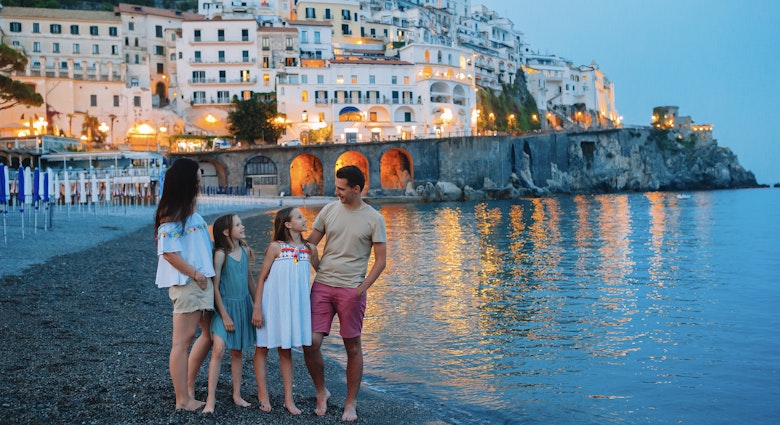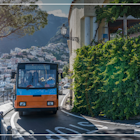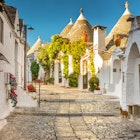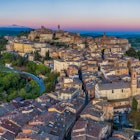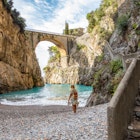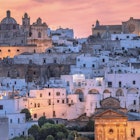A Unesco site in its entirety, Cilento is a vast and varied area in the southernmost part of Campania, Italy. Often overshadowed by its showy neighbors, Naples and the Amalfi Coast, the underrated Cilento enjoys more relaxed rhythms.
Beyond its most popular attraction, the Ancient Greek town of Paestum, there are many natural and man-made wonders that await you. If you’ve never heard of Cilento, its 80 towns, a national park, archaeological sights, mountains, hills, and miles and miles of beaches is what you’ve been missing out on. Not to mention the food and lifestyle that grant its residents near immortality – people here live much longer than in the rest of Italy. On average, 0.3 inhabitants out of 10 are over 100 years old.
Cilento is the home of the famed Mediterranean Diet that promises health and wellbeing without compromising on the life-affirming pleasures of delicious dining. The idea of “limiting carb intake” doesn’t exist here – bread and pasta are staples, as are legumes, fruit and vegetables from one’s own sun-drenched garden. People in these remote villages take things slow – part of Cilento's charm is the lack of mass tourism, so be respectful of this gentler approach to living.
You could easily spend a month visiting every town, trekking every path, and visiting every beach. If your vacation time is a little more limited, here's what we think you should prioritize on your first (but certainly not your last...) visit to Cilento.

Discover the best preserved Greek temples in Paestum
Almost 3000 years ago, the Ancient Greeks arrived on these shores. They populated the area with their ideas and customs, shaping the land and culture in their image. The Greek colony Poseidonia, later called Paestum, is the only surviving example of a Magna-Grecian town. Its three magnificent Greek temples are among the best preserved in the world.
The highlights are the two temples dedicated to Hera and a smaller one dedicated to Athena, which were built in Doric style in the fifth century BCE. You can also walk in the ruins of a Roman amphitheater, thermal baths, and various shops and houses. Download the Paestum phone app and enjoy a solo tour at your own pace.
The open-air archaeological park of Paestum is massive, but the experience is intimate: while carefully curated, it looks wild and unexplored, and you get to walk freely around the ruins. Compared to the ever-crowded Pompeii, this feels isolated and nestled in an idyllic landscape – even in high season, you may not encounter anyone else on your tour.
In summer, it’s best to walk the park in the early morning and then head inside the covered museum to escape the hot sun. There you can admire world-famous images like the Tomb of the Diver, as well as relics from Ancient Greek and Roman times.
For lunch, avoid the cafes and restaurants next to the site and instead drive 30 minutes north to Battipaglia. Pick a caseificio (cheese-making factory) and try their mozzarella di bufala DOP, as well as an array of various local dairy products.
Visit Europe’s biggest charterhouse in Padula
Venture to the inland town of Padula, in the heart of Vallo di Diano. There you can visit the largest charterhouse monastery in Europe, Certosa di San Lorenzo, first built in 1306.
Don’t be fooled by its unassuming exterior – inside the Certosa is a syncretism of styles, a triumph of Baroque juxtaposed against austere monastic spaces. The charterhouse’s structure is based on the typical concept of the monastery as a self-sufficient city, but the Certosa’s ornaments were embellished time and again over the centuries. The church, chapels, treasury, and dining halls are a testament to the splendor the Certosa once had, and are a stark contrast with the bare, tiny cells the Carthusian monks would sleep in.
You won’t run into any monks now, as the Certosa di Padula now operates as a museum, but you can still trace the steps they would take on their daily schedule. Pause in the Chiostro Grande, the massive cloister (104 x 149 meters) that took nearly two centuries to complete. The view is especially evocative because the town of Padula on top of the hill seems to dominate the Certosa.
The monastery also houses a museum, the Museo Archeologico Provinciale della Lucania Occidentale. The collection of tombs, vases, funerary items, columns and other items hosts archaeological findings from all over Vallo di Diano, dating back to the tenth century BCE until the sixth century CE.

Eat local produce and experience the Mediterranean Diet
The food that grows in Cilento is unlike any other in the world – and it’s as close to an immortality elixir as you're likely to get. American physiologist Ancel Keys (creator of the K-ration during WWII) spent most of his life studying the habits of Cilentani and codified the Mediterranean Diet here in Cilento.
The “diet” is less about excluding certain foods, but rather preferring some over others for reasons of availability. When in Cilento, eat as the Cilentani do: savor their local produce.
Enjoy some of Cilento’s typical pasta, the rigorously handmade fusilli cilentani (a type of elongated fusilli). The dish can come with a meat sauce or accompanied by local vegetables such as tomatoes, zucchini or eggplant. Whatever you have, make sure you get a taste of the white artichokes of Pertosa, either as a side, in a salad or as a spread.
You can't leave without trying the local charcuteries like their dried seasoned sausage or the soppressata di Gioi, along with the famous dairy products mozzarella and ricotta di bufala, and the wide variety of caciocavallo cheeses. Pair them with homemade jam and marmalades made from local produce, like Cilento’s white fig DOP, the sweetest in Italy. Have as much Cilento extra virgin olive oil as politely allowed, and always add spices and herbs to your dishes. Ask for polvere di peperone crusco (dust obtained from grinding a local pepper), the maroon seasoning that is often sprinkled onto vegetable dishes, which can be sweet or hot. Oh, and sprinkle rosemary onto your meat and potatoes… it’s believed to be the key ingredient to longevity.
The Mediterranean Diet is not just about food, but part of the lifestyle of Cilento in general. It’s how these foods are still cultivated and consumed as they have always been, in ways that are ethical and sustainable. In 2010 the Mediterranean Diet became protected by Unesco as Intangible Cultural Heritage, and Cilento is the perfect place to experience why it's considered so important.
Explore the Pertosa caves
The Grotte (caves) of Pertosa-Auletta are the only place in Italy where you can sail along an underground river. Dark and deep, the Pertosa grotte look like (and have been) the set of a horror movie, a feeling only softened by the colorful artificial lights. The temperature goes down significantly underground, so bring something warmer than your summer outfit, and be prepared for slippery stone floors.
A guided tour will bring you on a boat ride along the underground river before you alight and walk amidst thousands of stalactites and stalagmites forming incredible shapes, and discover the remains of civilizations that are four thousand years old.
Human presence has been documented in Cilento for half a million years, and the Grotte di Pertosa show signs of being inhabited since the mid-Bronze Age. They contain remains from prehistoric settlements and even traces of what was briefly and erroneously considered a different species of Paleolithic hominid, Homo Camaerotensis, a supposed missing link in human evolution.

Enjoy Cilento's sandy beaches
The beaches of Cilento sit along a coastal strip – over 100 kilometers long – facing emerald waters between the Gulf of Salerno and the Gulf of Policastro. Along the coast there are 16 towns and myriad smaller hamlets where you can enjoy the seaside with little fear of over-crowded cafes and restaurants.
If you’re a fan of sandy beaches or are traveling with children, consider the towns of Agropoli and Marina di Ascea for their golden-colored sand ample space for children to play. Driving south, the picturesque Punta Licosa welcomes you with crystalline waters, white sand and wild Mediterranean scrub; this land was once believed to be inhabited by sirens. Proceeding further south, stop at Acciaroli, the enchanting village where Ernest Hemingway was inspired to write The Old Man and the Sea.
Head to the archaeological site of Velia for a history lesson or a theater show and visit the ruins of the ancient city of Elea, which gave birth to the Greek philosopher Parmenides and his school of thought. If you’re also visiting Paestum, one ticket will be valid for both sites.
Don’t miss the natural beauty of the protected beaches of Santa Maria di Castellabate and Costa degli Infreschi e della Masseta, or the marine grottoes on the coast of Palinuro and Marina di Camerota.
How to get to Cilento and where to stay
Cilento is best explored by car – there are limited public transportation options inland. A few train stations in Vallo di Diano exist but have been closed for years; the closest is Battipaglia. From there, the national railway service runs a handful of substitute buses every day to and from Napoli, while the public bus company SITA Sud also runs services between Salerno and Pertosa.
Even with those optoins, bus services can be sporadic. Independent travel by car is much more convenient and gives you optimal flexibility. Public transport is much more plentiful along the coast, as regional trains (Trenitalia), high-speed ones (Italo), and public buses connect most towns and run multiple times per day.
The closest airport is the Airport of Naples in Capodichino; from there, it will be a couple of hours drive depending on which part of Cilento you want to reach first. The new airport Salerno-Costa d’Amalfi just outside of Salerno will be slightly closer to Cilento; it is expected to open for commercial flights in 2024.
A lovely place to stay and relax while getting the full local experience in Padula is Fattoria Alvaneta, a family-run hilltop B&B farm that can be a challenge to get to even by car, but is definitely worth it. Their dinner menu is based on local produce – authentic, filling and simply delicious.
For a lively holiday, pick a hotel or camping site in the seaside towns of Ascea, Palinuro, or Marina di Camerota. You’ll be close to the beach with many options for activities in and out of the water. From there you can easily move up and down the coast by car or train.



